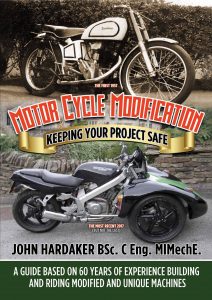
Blurring the Edges. Buying, assembling, and teaching myself to use a 770MX Tormach® CNC milling machine. My journey from distinctly novice to relative competence by Steve Dunthorne
Price: £19.99
ISBN: 978-1-914933-30-1
The author is a somewhat frustrated ‘weekend engineer’ with a small lathe and an old manual milling machine in his garage, whose day job doesn’t reflect his passion for making mechanical things. A chance discussion with a colleague culminated in him ordering a brand-new CNC (Computerised Numerical Control) mill from the USA. The machine is a Tormach® 770MX, a model aimed unashamedly at the high end of the hobbyist market, and certainly attracting the attention of small independent manufacturing ‘start-ups’, particularly in the United States.
This book records his journey of getting to grips with assembling all the components and learning how to operate the machine. It is purposely not an instruction manual – the manufacturer has already seen to that need. It is more a chronological log of all processes from choosing the right machine through to getting it to make parts. Taking the not insignificant leap from manual machining to CNC manufacturing, in the domestic environment, is a steep learning curve and this book is intended to assist, with many top tips gleaned from ‘learning the hard way’, shared throughout.
There are other excellent books out there, some mainly theoretical references, some siding with historical interest. The author envisaged a need for something more practical and hands-on. When he began his project, he couldn’t find a book like this.
Motorcycle Modification: Keeping Your Project Safe by John Hardaker

Motorcycle Modification: Keeping Your Project Safe by John Hardaker
Non-Fiction
Price: Hardback £15.98
ISBN: 978-1-9163097-4-6
There are many types of Motorcycle Modification ranging from minor adjustments to suit the riders physique or preferences to creation of almost completely new machines with very little of the original remaining. In between there are many possibilities including changes to the bikes appearance to differentiate it from the mass of identical production machines, changes to improve performance, handling, or reliability, changes to classic bikes to make them more usable in modern road conditions, or just attempts to create the modifiers vision of his perfect bike.
All these types of modification have one thing in common, the overriding need to ensure that the change does not make the machine less safe to ride than the original. This book proposes a simple method, based on long established aircraft and aero engine practices, of reviewing any intended modification at an early stage so that any possible safety problems can be avoided.
The book is more than just a basic manual and incorporates numerous sketches and photographs to illustrate various points together with many memories from a long career, various related and unrelated thoughts and a few original and possibly controversial suggestions which occurred to the author at the time of writing. It invites the reader to either agree or disagree with any or all of these deviations from the basic principles of the method. There is also an attempt to predict the future of motorcycle development and modification.
The book avoids much engineering theory to ensure that it is readily understandable to anyone who does not claim to be an engineer or contemplate modifying a motorcycle but is just interested in all things mechanical. It may also be useful to young engineers embarking on an interesting and rewarding career by offering many insights into the engineering world which are not usually included in engineering courses.
Author John Hardaker is a retired engineer with long experience of the aircraft and aero engine industries and a life time hobby of producing modified and unique vehicles on 2, 3 and 4 wheels.
He has written this book in the hope of passing on some of the things he has learned, often the hard way, over the years and in particular to promote the basic thinking behind long established and well proven aero industry methods of ensuring safety in use.
He was born in Colne, Lancashire in 1937 and was educated at Colne Grammar School followed by a Student Apprenticeship with English Electric Aviation at Warton, during which he gained a good general understanding of how many aspects of the aircraft industry work and a degree in aeronautical engineering.
He made the move to the aero engine industry in 1964 and stayed, latterly specialising in Certification and Safety Analysis, until he retired for the first time in 1996. He continued to work on a part time basis on many different aero and marine engine projects in UK and Europe until the age of 80, when he finally retired.
Married with one daughter he now lives in North Yorkshire and still has various special building projects in progress.





